Janome 2030DC, JNH1860, JNH2030DC Instruction Manual
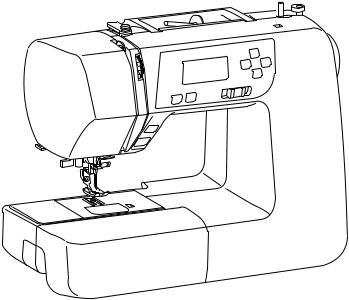
INSTRUCTION BOOK

IMPORTANT SAFETY INSTRUCTIONS
This appliance is not intended for use by persons (including children) with reduced physical, sensory or mental capabilities, or lack of experience and knowledge, unless they have been given supervision or instruction concerning use of the appliance by a person responsible for their safety.
Children should be supervised to ensure that they do not play with the appliance.
When using an electrical appliance, basic safety precautions should always be followed, including the following:
This sewing machine is designed and manufactured for household use only.
Read all instructions before using this sewing machine.
DANGER— To reduce the risk of electric shock:
An appliance should never be left unattended when plugged in. Always unplug this sewing machine from the electric outlet immediately after using and before cleaning.
WARNING— To reduce the risk of burns, fire, electric shock, or injury to persons:
1.Do not allow to be used as a toy. Close attention is necessary when this sewing machine is used by or near children.
2.Use this appliance only for its intended use as described in this owner’s manual.
Use only attachments recommended by the manufacturer as contained in this owner’s manual.
3.Never operate this sewing machine if it has a damaged cord or plug, if it is not working properly, if it has been dropped or damaged, or dropped into water.
Return this sewing machine to the nearest authorized dealer or service center for examination, repair, electrical or mechanical adjustment.
4.Never operate the appliance with any air opening blocked. Keep ventilation openings of this sewing machine and foot controller free from accumulation of lint, dust and loose cloth.
5.Never drop or insert any object into any opening.
6.Do not use outdoors.
7.Do not operate where aerosol (spray) products are being used or where oxygen is being administered.
8.To disconnect, turn all controls to the off (“O”) position, then remove plug from outlet.
9.Do not unplug by pulling on cord. To unplug, grasp the plug, not the cord.
10.Keep fingers away from all moving parts. Special care is required around the sewing machine needle.
11.Always use the proper needle plate. The wrong plate can cause the needle to break.
12.Do not use bent needles.
13.Do not pull or push fabric while stitching. It may deflect the needle causing it to break.
14.Switch this sewing machine off (“O”) when making any adjustment in the needle area, such as threading the needle, changing the needle, threading the bobbin or changing the presser foot, and the like.
15.Always unplug this sewing machine from the electrical outlet when removing covers, lubricating, or when making any other adjustments mentioned in this owner’s manual.
SAVE THESE INSTRUCTIONS
Please note that on disposal, this product must be safely recycled in accordance with relevant National legislation relating to electrical/electronic products. If in doubt please contact your retailer for guidance. (European Union only)
TABLE OF INSTRUCTION
SECTION I. NAMES OF PARTS |
|
Names of Parts ............................................................. |
2 |
Standard Accessories ................................................... |
3 |
Extension Table ............................................................. |
3 |
SECTION II. GETTING READY TO SEW |
|
Connecting the Power Supply ....................................... |
4 |
Before Using Your Sewing Machine .............................. |
4 |
Speed Control Slider ..................................................... |
5 |
Controlling Sewing Speed ............................................ |
5 |
Machine Operating Buttons........................................ |
6-7 |
Removing and Attaching the Foot Holder ..................... |
8 |
Changing the Presser Foot ........................................... |
8 |
Presser Foot Lifter ........................................................ |
8 |
Dropping or Raising the Feed Dog ............................... |
9 |
Changing the Needle .................................................... |
9 |
Selecting Thread and Needles ..................................... |
9 |
Bobbin Winding ...................................................... |
10-12 |
Threading the Machine ............................................... |
13 |
Needle Threader ......................................................... |
14 |
Drawing up the Bobbin Thread ................................... |
15 |
LCD Display ................................................................ |
16 |
Stitch Patterns............................................................. |
16 |
Adjusting the Needle Thread Tension |
|
for a Straight Stitch .................................................... |
17 |
Adjusting the Needle Thread Tension |
|
for a Zigzag Stitch ...................................................... |
18 |
SECTION III. BASIC SEWING |
|
Straight Stitch Sewing ................................................. |
19 |
Needle Plate ............................................................... |
20 |
Straight Stitch.............................................................. |
21 |
Lock-a-Matic Stitch ..................................................... |
21 |
Locking Stitch .............................................................. |
21 |
Triple Stretch Stitch ..................................................... |
21 |
Stretch Stitch............................................................... |
22 |
Sculpture Stitch ........................................................... |
22 |
Zigzag Stitch ............................................................... |
23 |
Overcasting with Zigzag Stitch ................................... |
24 |
Multiple Zigzag ............................................................ |
24 |
Overedge Stitch .......................................................... |
24 |
Various Kinds of Buttonholes and Their Uses ............. |
25 |
Square Buttonhole ................................................. |
26-27 |
Adjusting the Stitch Width and Density for |
|
Buttonholes ................................................................ |
28 |
Round-End Buttonhole ............................................... |
28 |
Keyhole Buttonhole ..................................................... |
28 |
Corded Buttonhole ...................................................... |
29 |
Darning Stitch ............................................................. |
30 |
Tacking ........................................................................ |
31 |
Eyelet .......................................................................... |
31 |
Zipper Sewing ........................................................ |
32-33 |
Blind Hemming............................................................ |
34 |
Button Sewing ............................................................. |
35 |
SECTION IV. DECORATIVE STITCHING |
|
Shelltuck Stitch ........................................................... |
35 |
Applique ...................................................................... |
36 |
Patchwork Piecing ...................................................... |
36 |
Fagoting ...................................................................... |
37 |
Satin Stitches .............................................................. |
37 |
Decorative Stitch Combinations.................................. |
38 |
Correcting Distorted Stitch Patterns ........................... |
38 |
SECTION V. CARE OF YOUR MACHINE |
|
Cleaning the Hook Race and Feed Dog ..................... |
39 |
Installing the Bobbin Holder ........................................ |
39 |
Problems and Warning Signs ..................................... |
40 |
Troubleshooting ........................................................... |
41 |
1
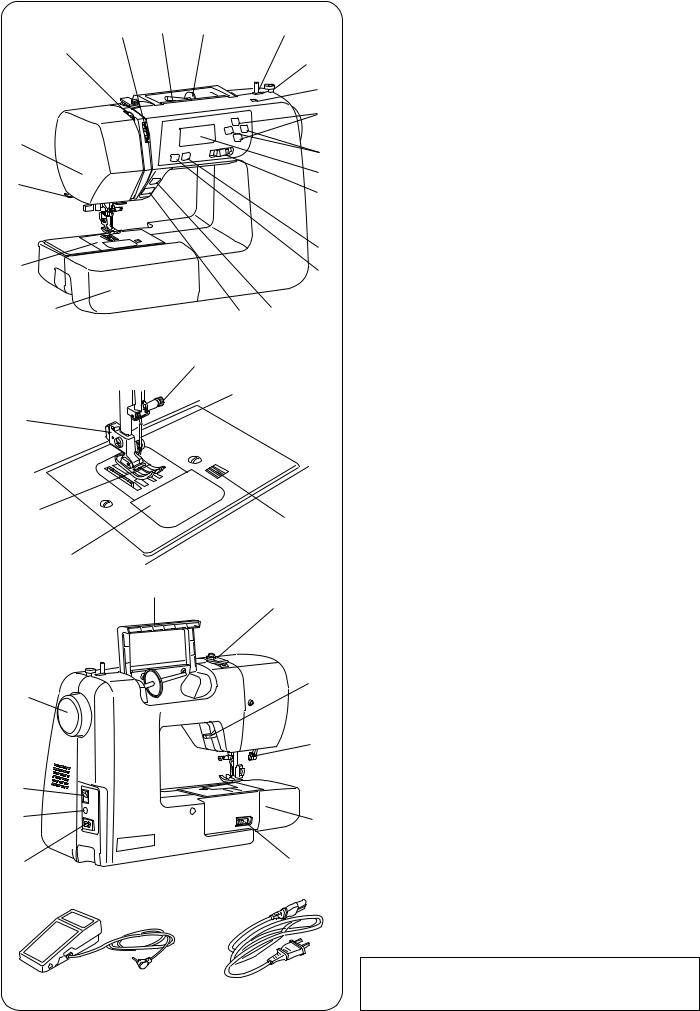
u i o
y
t
r
e
w
q
@4
@3
@2
@1
#1
#0
!0
!1
!2
!3
!4
!5
!6
!7
!8
@0 !9
@5
@6
#2
#3
#4
@9 |
|
@8 |
#5 |
|
|
@7 |
#6 |
#7 |
#8 |
SECTION I. NAMES OF PARTS
Names of Parts
q Extension table (Accessory box) w Needle plate
e Needle threader r Thread cutter t Face cover
y Thread take-up lever u Thread tension dial i Spool pin
o Large spool holder !0Bobbin winder spindle !1Bobbin winder stopper !2Hole for additional spool pin !3Value set buttons !4Cursor buttons
!5LCD display !6Speed control slider !7Needle up/down button !8Auto-lock button !9Reverse stitch button @0Start/stop button @1Hook cover plate
@2Presser foot (Zigzag foot A) @3Foot holder
@4Needle clamp screw @5Needle
@6Hook cover release button @7Power inlet
@8Foot control jack @9Power switch #0Handwheel #1Carrying handle #2Upper thread guide #3Presser foot lifter #4Buttonhole lever #5Free-arm
#6Drop feed lever #7Foot control #8Power supply cord
NOTE:
Sewing machine design and specifications are subject to change without prior notice.
2
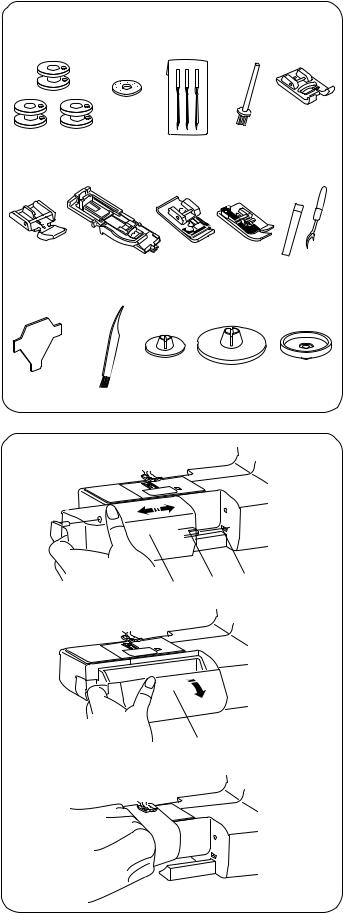
|
|
|
|
|
|
Standard Accessories |
q |
|
w |
e |
r |
t |
q Bobbin |
|
w Spool pin felt |
|||||
|
|
|
|
|
|
|
|
|
|
|
|
|
e Needle set |
|
|
|
|
|
|
r Additional spool pin |
|
|
|
|
|
|
t Satin stitch foot F |
|
|
|
|
|
|
y Zipper foot E |
y |
u |
|
i |
o |
!0 |
u Automatic buttonhole foot R |
|
i Overedge foot C |
|||||
|
|
|
|
|
|
|
|
|
|
|
|
|
o Blind hem foot G |
|
|
|
|
|
|
!0Seam ripper (Buttonhole opener) |
|
|
|
|
|
|
!1Screwdriver key |
|
|
|
|
|
|
!2Lint brush |
!1 |
|
!2 |
!3 |
!4 |
!5 |
!3Small spool holder |
|
|
|
|
|
|
!4Large spool holder |
|
|
|
|
|
|
!5Spool stand |
q w e
r
Extension Table
The extension table q provides an extended sewing area and can be easily removed for free arm sewing.
q Extension table w Tab
eSlot
•Detaching the table
Pull the table away from the machine, as illustrated.
• Attaching the table
Push the extension table, inserting the tab w into the slot
euntil the table snaps into the machine.
•Accessory storage
Accessories are stored inside the extension table. Pull lid towards you to open the accessory storage r.
rAccessory storage
•Free-arm sewing
Free-arm sewing is useful for darning socks or mending knees, cuffs or areas of wear in children’s clothes.
3
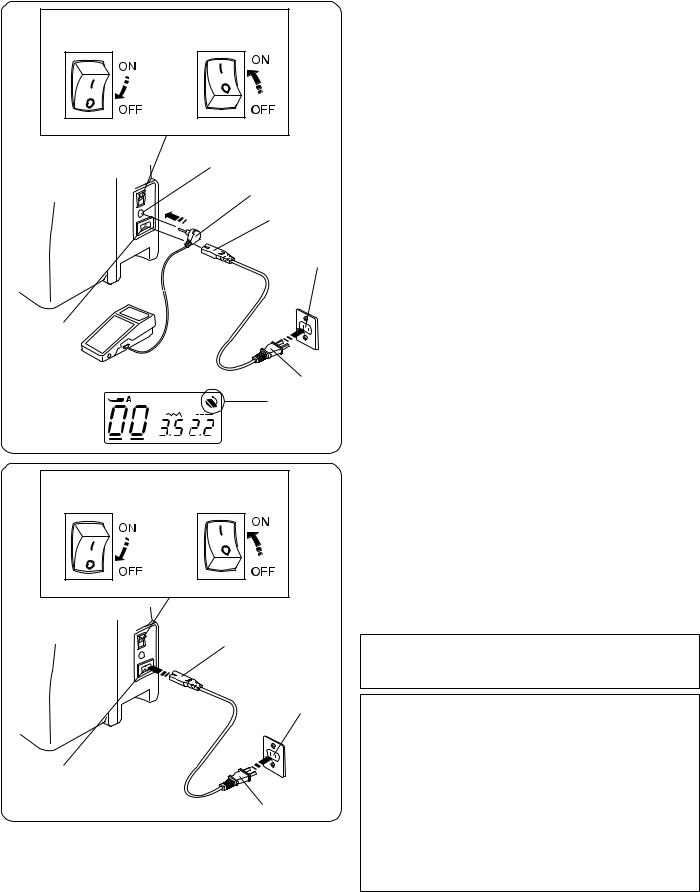
q |
SECTION II. GETTING READY TO SEW |
|
|
Connecting the Power Supply |
|
|
• Using the foot control |
|
|
Turn off the power switch q. |
|
|
Insert the foot control plug w into the foot control jack e. |
|
|
Insert the machine plug r into the power inlet t. |
|
|
Insert the power supply plug y into the wall outlet u. |
|
|
Turn on the power switch q. |
|
e |
The foot control sign i will be displayed when the |
|
foot control is connected to the machine. |
||
w |
q Power switch |
|
w Foot control plug |
||
|
||
r |
e Foot control jack |
|
|
r Machine plug |
|
|
t Power inlet |
|
u |
y Power supply plug |
|
|
u Wall outlet |
|
|
i Foot control sign |
|
t |
|
y
i
q
w
t
e
r
Operating Instructions:
The symbol “O” on a switch indicates the “off” position of a switch.
For appliances with a polarized plug (one blade wider than the other): To reduce the risk of electric shock, this plug is intended to fit in a polarized outlet only one way. If it still does not fit, contact a qualified electrician to install the proper outlet. Do not modify the plug in any way (U.S.A. and Canada only).
*Foot control model YC-485EC-1 is used with this sewing machine (U.S.A and Canada only).
•Using the start/stop button
Turn off the power switch q.
Insert the machine plug w into the power inlet e. Insert the power supply plug r into the wall outlet t. Turn on the power switch q.
q Power switch w Machine plug e Power inlet
r Power supply plug t Wall outlet
NOTE:
The start/stop button does not work when the foot control is connected.
 WARNING:
WARNING:
While in operation, always keep your eyes on the sewing area, and do not touch any moving parts such as the thread take-up lever, handwheel or needle.
Always turn off the power switch and unplug from the power supply:
-when leaving the machine unattended.
-when attaching or removing parts.
-when cleaning the machine.
Do not place anything on the foot control, otherwise the machine will run inadvertently.
Before Using Your Sewing Machine
Before using your sewing machine for the first time, place a scrap of fabric under the presser foot and run the machine without thread for a few minutes. Wipe away any oil which may appear.
4
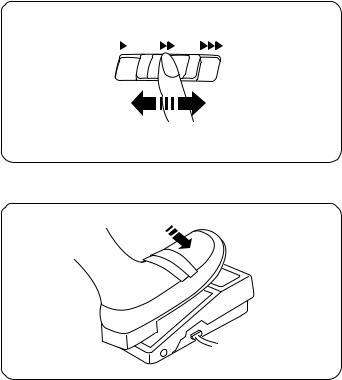
Speed Control Slider
Sewing speed can be varied by the speed control slider according to your sewing needs.
To increase sewing speed, slide the slider to the right. To decrease sewing speed, slide the slider to the left.
Controlling Sewing Speed
Depress the foot control to start the machine.
The further down you press on the foot control, the faster the machine runs.
The maximum sewing speed can be varied by the speed control slider.
5
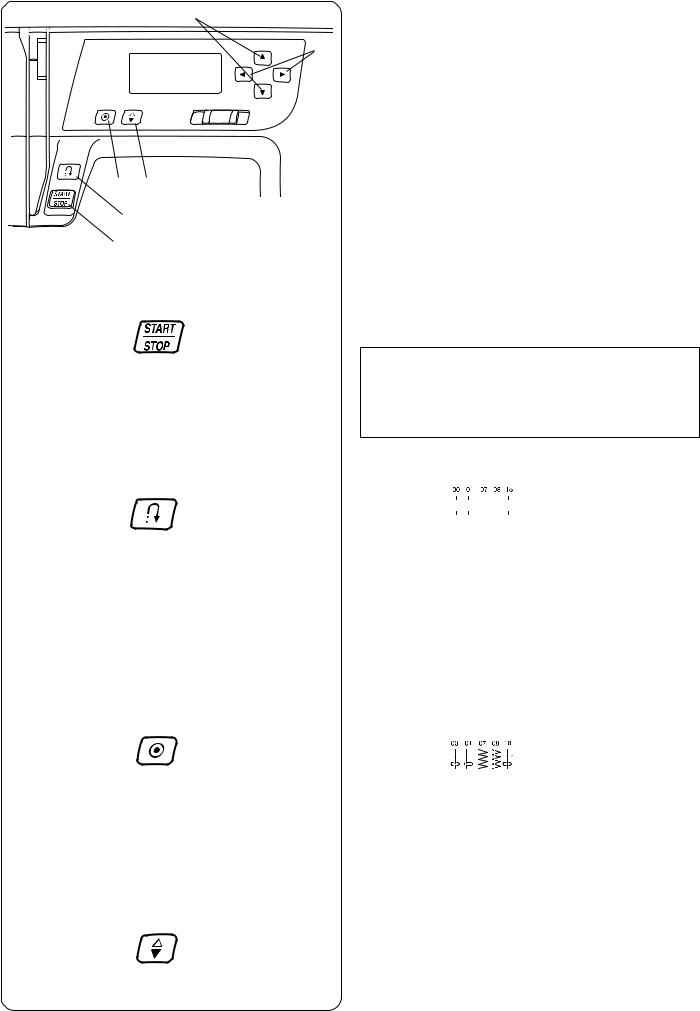
er
w q
q
w
e
r
y |
Machine Operating Buttons |
|
t |
q Start/Stop Button
Lower the presser foot lifter.
Press the start/stop button to start the machine. The machine starts running slowly for the first few
stitches; it then runs at the speed set by the speed control slider.
Press the start/stop button again to stop the machine.
NOTES:
•The machine runs slowly as long as you press and hold the start/stop button.
•The start/stop button cannot be used when the foot control is connected to the machine.
w Reverse Stitch Button
When stitches 





 (00, 01, 07, 08, 18) are selected, the machine will sew in reverse while the reverse stitch button is pressed.
(00, 01, 07, 08, 18) are selected, the machine will sew in reverse while the reverse stitch button is pressed.
If you press the reverse stitch button when sewing any other stitches, the machine will immediately sew locking stitches and automatically stop.
If you press the reverse stitch button when stitch pattern 00, 01, 07, 08 or 30 is selected and the foot control is not connected, the machine will sew in reverse as long as the button is pressed, and the machine will stop when the button is released.
e Auto-lock Button
When stitches |
(00, 01, 07, 08, 18) are |
selected, the machine will immediately sew locking stitches and automatically stop when the auto-lock button is pressed.
If you press the auto-lock button when sewing any other stitches, the machine will sew locking stitches at the end of the current pattern and automatically stop.
r Up/down Needle Position Button
Press this button to bring the needle up or down. The machine will stop with the needle up or down depending on the needle position determined by this button.
6
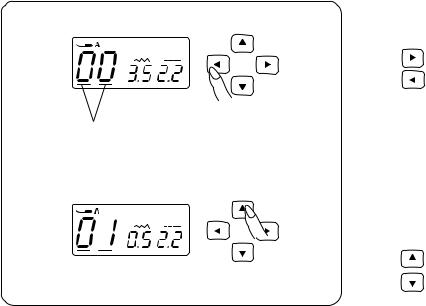
t Cursor Buttons
t |
|
Use these buttons to move the cursor u. |
|
Press |
button to move the cursor to right. |
Press |
button to move the cursor to left. |
u |
|
y |
y Value Set Buttons |
|
|
Use these buttons to change the set value. |
|
|
Move the cursor under the digit you would like to change. |
|
|
Press |
button to increase the value. |
|
Press |
button to decrease the value. |
7
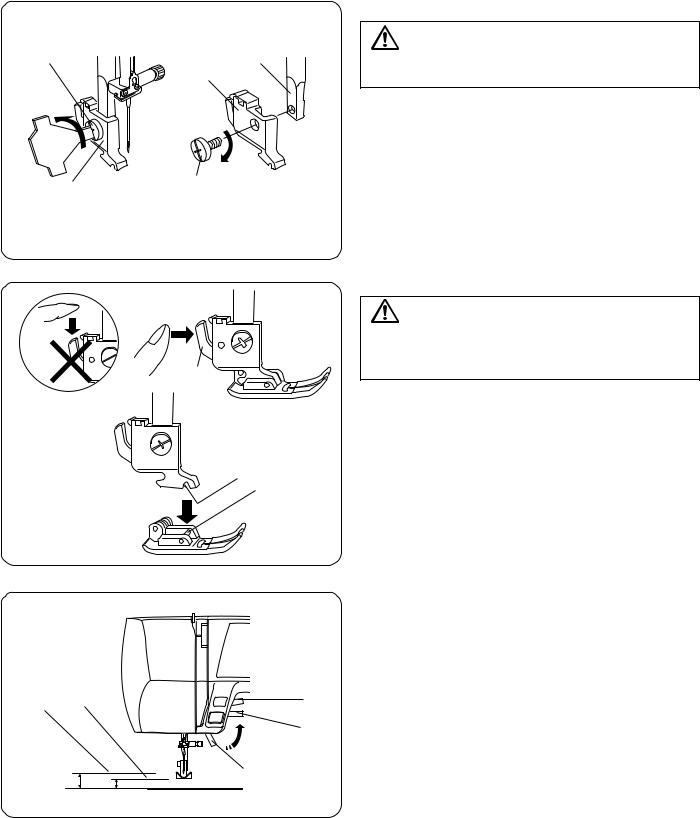
|
|
|
Removing and Attaching the Foot Holder |
|
|
|
CAUTION: |
q |
|
e |
Turn OFF the power switch before detaching or |
|
|
w |
attaching foot holder. |
|
|
|
• Removing the foot holder |
|
|
|
Remove the setscrew q by turning it counterclockwise |
|
|
|
with a screwdriver. |
|
|
|
• Attaching the foot holder |
|
|
|
Match the hole in the foot holder w with the threaded |
|
w |
q |
hole in the presser bar e. Fit the setscrew q into |
|
|
the hole. Tighten the setscrew q by turning it clockwise |
|
|
|
|
|
|
|
|
with a screwdriver. |
|
|
|
q Setscrew |
|
|
|
w Foot holder |
|
|
|
e Presser bar |
z |
|
|
Changing the Presser Foot |
|
|
|
|
|
|
|
CAUTION: |
|
|
|
Turn OFF the power switch before changing the foot . |
|
|
|
Always use the proper foot for the selected pattern. |
|
|
q |
The wrong foot can cause the needle to break. |
|
|
|
|
|
|
|
• Removing the presser foot |
|
|
|
Raise the needle to its highest position by turning the |
x |
|
|
handwheel counterclockwise. Raise the presser foot, |
|
|
|
and press the lever q on the back of the foot holder. |
|
|
|
• Attaching the presser foot |
|
|
w |
Place the selected presser foot so that the pin e on |
|
|
the foot lies just under the groove w on the foot |
|
|
|
e |
|
|
|
|
holder. Lower the presser bar to lock the foot into |
|
|
|
the place. |
|
|
|
q Lever |
|
|
|
w Groove |
|
|
|
e Pin |
|
|
|
Presser Foot Lifter |
|
|
|
The presser foot lifter q raises and lowers the presser |
|
|
|
foot. |
|
|
|
You can raise the foot about 1/4˝ (0.6 cm) higher than the |
|
|
|
normal up position w for easy removal of the presser |
|
|
|
foot, or to help you place thick material under the foot. |
e |
w |
e |
q Presser foot lifter |
|
|
w Normal up position |
|
|
|
|
|
|
|
w |
e Highest position |
|
|
q |
|
8
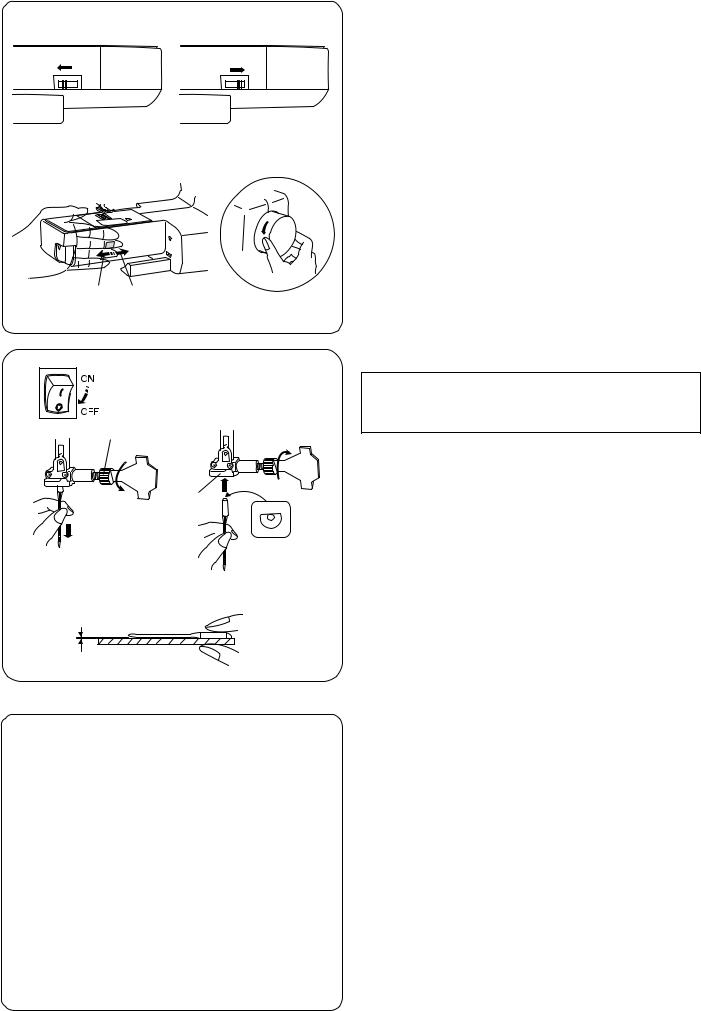
Dropping or Raising the Feed Dog
The drop feed lever is located underneath the free arm bed on the back of the machine.
q w
q To drop the feed dog, push the lever in the direction of the arrow q.
w To raise the feed dog, push the lever in the direction of the arrow w, as illustrated, and turn the handwheel e toward you. The feed dog must be up for normal sewing.
e
wq
z |
x |
q
w
c
Fabric |
Thread |
Needle |
|
|
|
|
|
|
|
|
Lawn |
Silk #80-100 |
#9/65–11/75 |
|
Light |
Georgette |
Cotton #80-100 |
|
|
Tricot |
Synthetic #80-100 |
|
|
|
|
Wool, |
|
|
|
|
Polyester |
|
|
|
|
|
|
|
|
|
Cotton, |
Silk #50 |
#11/75–14/90 |
|
Medium |
Polyester |
Cotton #60-80 |
|
|
|
Fine jersey |
Synthetic #50-80 |
|
|
|
Wool |
Cotton #50 |
#14/90 |
|
|
|
|
|
|
|
Denim |
Silk #50 |
#14/90–16/ |
|
Heavy |
Jersey |
Cotton #40-50 |
100 |
|
Coating |
Synthetic #40-50 |
|
|
|
|
|
|
||
|
Quilting |
Silk #30 |
|
|
|
|
Cotton #50 |
#16/100 |
|
|
|
|
|
|
|
|
|
|
|
Changing the Needle
 CAUTION:
CAUTION:
Turn OFF the power switch before changing the needle.
zTurn off the power switch.
Raise the needle to its highest position by turning the handwheel counterclockwise, and lower the presser foot. Loosen the needle clamp screw q by turning it counterclockwise. Remove the needle from the needle clamp w.
xInsert a new needle into the needle clamp w with the flat side to the rear. When inserting the needle into the needle clamp w, push it up as far as it goes. Tighten the needle clamp screw q firmly by turning it clockwise.
cTo see if the needle is good, place the flat side of the needle onto something flat (needle plate, glass, etc.). The gap between the needle and the flat surface should be consistent. Never use a bent or blunt needle.
A damaged needle can cause permanent snags or runs in knits, fine silks and silk-like fabrics.
q Needle clamp screw w Needle clamp
Selecting Thread and Needles
For general sewing, use needle size 11/75 or 14/90. A fine thread and needle should be used for sewing lightweight fabrics, so the fabric will not be marred. Heavy fabrics require a needle large enough to pierce the fabric without fraying the needle thread.
Always test the needle size on a small scrap of the fabric, which will be used for actual sewing.
In general, use the same thread for the needle and bobbin. When sewing stretch fabrics, very fine fabrics and synthetics, use a BLUE TIPPED needle. The blue tipped needle effectively prevents skipped stitches.
9
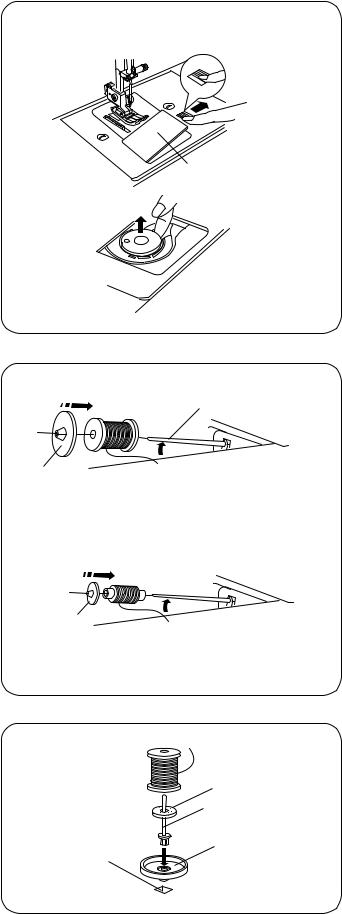
Bobbin Winding
• Removing the bobbin
Gently slide the hook cover release button q to the
 q right and remove the hook cover plate w.
q right and remove the hook cover plate w.
Lift out the bobbin.
q Hook cover release button w Hook cover plate
w
|
• Horizontal spool pin |
q |
Lift up the spool pin q. Place a spool of thread on the |
spool pin with the thread coming off the spool as shown. |
|
|
Attach the large spool holder w, and press it firmly |
|
against the spool of thread. |
|
The small spool holder e is used with narrow or small |
w |
spools of thread. |
q Spool pin
w Large spool holder e Small spool holder
e
• Additional spool pin
The additional spool pin w is for winding bobbins, without unthreading the machine.
r Set the spool stand q under the additional spool pin w.
w
Insert the additional spool pin w into the hole e.
Place the felt r and a spool on the pin.
|
q |
q Spool stand |
|
w Additional spool pin |
|
e |
|
|
|
e Hole for additional spool pin |
|
|
|
|
|
|
r Spool pin felt |
10
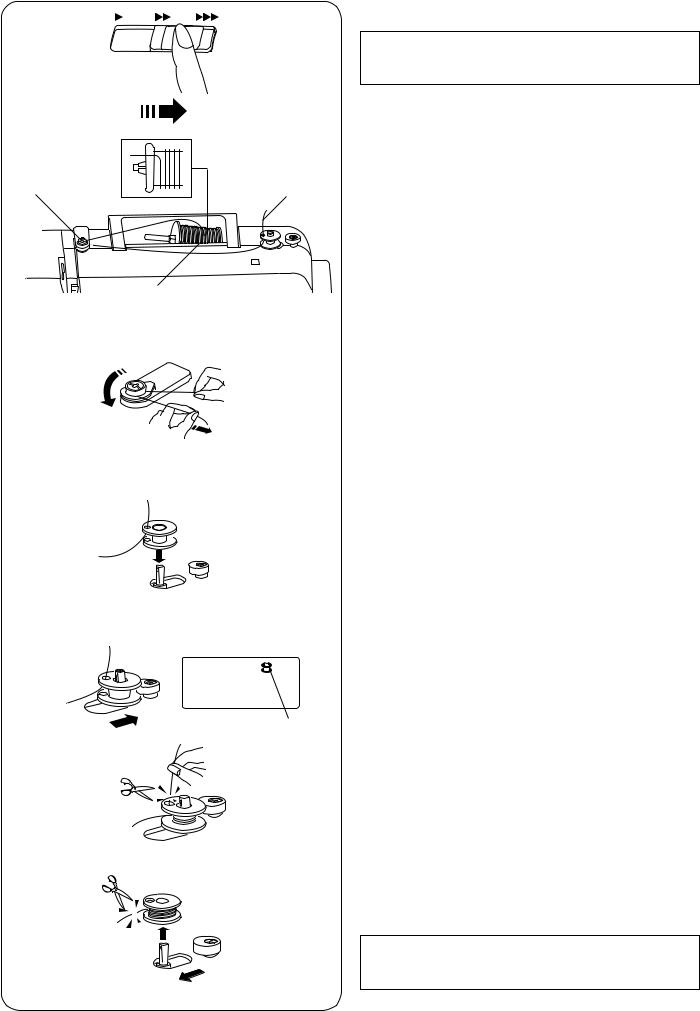
• Winding the bobbin
NOTE:
Set the speed control slider at its fastest position for bobbin winding.
x |
c |
z
x
c v
z Draw the thread from the spool.
x Guide the thread around the thread guide.
cThread through the hole in the bobbin from the inside to the outside.
v Put the bobbin on the bobbin winder spindle.
b |
b Push the bobbin to the right. |
|
The bobbin sign q appears on the LCD display. |
|
q |
n |
n With the free end of the thread held in your hand, |
|
start the machine. Stop the machine when it has |
|
wound a few layers, and then cut the thread close to |
|
the hole in the bobbin. |
m |
m Start the machine again. When the bobbin is fully |
|
wound, it will stop automatically. Stop the machine |
|
and return the bobbin winder to its original position by |
|
moving the spindle to the left. Cut the thread as |
|
shown. |
|
NOTE: |
|
For safety purposes, the machine will stop automatically |
|
2 minutes after the start of bobbin winding. |
11
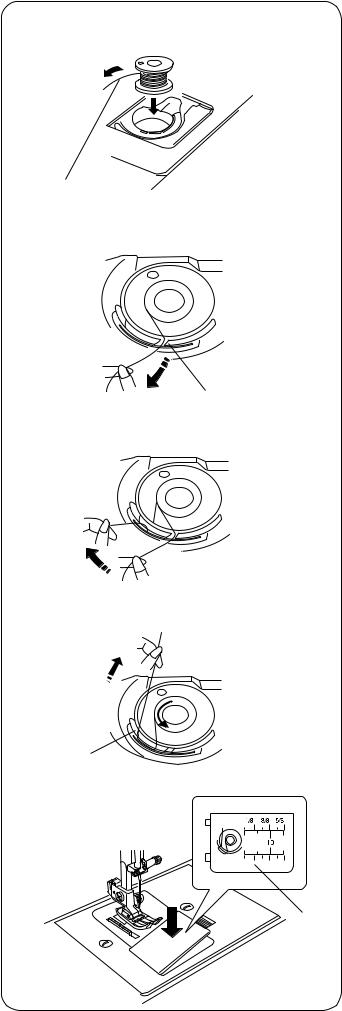
|
• Inserting the bobbin |
z |
z Place a bobbin in the bobbin holder with the thread |
|
running off counterclockwise. |
|
q End of thread |
q
x |
x Guide the thread into the first notch w on the front |
|
side of the bobbin holder. |
|
w Notch |
|
w |
c |
c Draw the thread to the left, sliding it between the |
|
tension spring blades. |
v |
v Continue to draw the thread lightly until the thread |
|
slips into the second notch e. Pull out about 6˝ |
|
(15 cm) of thread. |
|
e Notch |
|
e |
b |
b Attach the hook cover plate. Check the threading by |
|
referring to the diagram r shown on the hook cover |
|
plate. |
|
r Threading diagram |
|
r |
12
